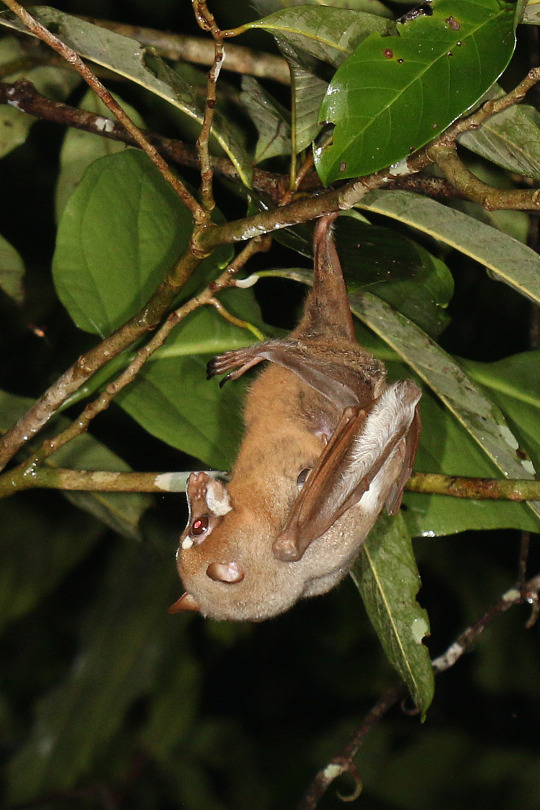Observation of the Week, 12/29/16

This Wallace’s Stripe-faced Fruit Bat, seen in Indonesia by @martinmandak, is our Observation of the Week!
“Bats were one of reasons why I undertook the quite arduous journey to the remote "corner" of Sulawesi (and definitely I do not regret that),” says Martin Mandak. “Sulawesi is one of the bats' hotspot (more than 60 species). On the other hand, Sulawesian bats have hard life due to habitat destruction and extensive bushmeat hunting resulting in steep decline of many populations. Tompotika Peninsula (Central Sulawesi) is becoming a save haven for fruit bats thanks to amazing work of Alliance for Tompotika.”
“During my last night in Tanah Merah village (one of conservation centres in the peninsula),” he recalls, “I explored a tiny remnant of rainforest near the village. The lonely [Wallace’s Stripe-faced Fruit Bat] with beautifully colored face was calmly hanging above a path and let me approach to itself very closely.”
Martin’s observation is the first one for this species on iNaturalist, and it is listed as Near-threatened by the IUCN. Named after Charles Darwin’s correspondent Alfred Russel Wallace, who had collected the first specimen, this bat is found only on the island of Sulawesi and some nearby smaller islands. Unlike insectivorous bats, fruit bats have much better vision, which they use in conjunction with their noses to find suitable fruits and nectar to eat. In fact, only a select few species are able to use echolocation! Oh, and the ones who dine on nectar have amazing tongues that actually retract around their ribcages. Actually make that really amazing tongues.

Professionally, Martin Mandak evaluates buildings “before thermal insulation to avoid conflicts with nesting of synanthropic birds (and bats to lesser degree)” and is member of the committee of the Silesian Ornithological Society, a branch of Czech Society for Ornithology (BirdLife partner in the Czech Republic). As a naturalist, he is especially interested in birds, reptiles, amphibians, bats, and insects.
“I use iNaturalist particularly for 1) sharing pictures of more overlooked groups of animals and 2) as a site where my observations can be IDed,” says Martin “In my opinion, the most useful iNaturalist features are projects with active leaders, who motivate observers to raise interest of ‘their’ groups of animals. To name at least one, I would mention AfriBats and very helpful @jakob.”
- by Tony Iwane
- Some cool facts about Flying Foxes, the world’s largest fruit bats.
- Here are some pretty adorable rescued baby fruit bats at the Australian Bat Center.
- Sir David Attenborough on Alfred Russel Wallace.





Comentários
Very cool!
This is such an awesome observation, I'm very happy to see that it has been selected as the Obs of the Week! Congrats, Martin, for finding this and so many other interesting critters!
It's also an excellent observation to show that there are many bat species which are actually quite colourful. Check out these beautiful bats: Casinycteris ophiodon, Diclidurus albus, Ectophylla alba, Glauconycteris superba, Glauconycteris variegata, Lavia frons, Myotis welwitschii, and Pteropus capistratus.
The Welwitsch's mouse-eared bat (Myotis welwitschii) and Variegated Butterfly Bat (Glauconycteris variegata) are interesting! I wonder what the reason is for the patterned wings.
And I've said this before, but the Pied Bat (Glauconycteris superba) is a darn attractive bat.
Hi Matt, Glauconycteris spp have been found openly roosting in vegetation (like Lasiurus spp in the New World), so it's probably a disruptive colouration that helps to conceal the bat during the day. Same has been suggested for Myotis welwitschii (and the almost identically coloured M. formosus), but their case is less conclusive as these bats regularly roost in caves. But then incredible Kerivoula picta is known to roost openly in vegetation, and has a similar colouration as these Myotis species...
Happy New Year, by the way!
Happy New Year Jakob!
To continue the thread on colourful bats - here some stunning BBC footage of the painted bat, Kerivoula picta, from Thailand:
www.bbc.co.uk/programmes/p04njz5k
Thanks, Jakob! What amazing bats you mentioned above and fantastic video from Thailand!
Adicionar um Comentário